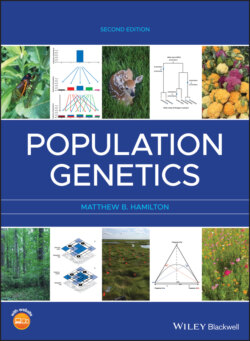Читать книгу Population Genetics - Matthew B. Hamilton - Страница 53
Further reading
ОглавлениеFor a detailed history of Gregor Mendel's research in the context of early theories of heredity as well as the analysis of Mendel's results by subsequent generations of scientists, see:
1 Orel, V. (1996). Gregor Mendel: The First Geneticist. Oxford: Oxford University Press.For perspectives on whether or not Gregor Mendel may have fudged his data, see a set of articles published together:
2 Myers, J.R. (2004). An alternative possibility for seed coat color determination in Mendel's experiment. Genetics 166: 1137.
3 Novitiski, C.E. (2004). Revision of Fisher's analysis of Mendel's garden pea experiments. Genetics 166: 1139–1140.
4 Novitiski, E. (2004). On Fisher's criticism of Mendel's results with the garden pea. Genetics 166: 1133–1136.More on the history of GH Hardy's contributions to expected genotype frequencies is explained in:
5 Edwards, A.W.F. (2008). G. H. Hardy (1908) and Hardy–Weinberg equilibrium. Genetics 179: 1143–1150.For a brief biography of Reginald Punnett and his work on expected genotype frequencies, see:
6 Edwards, A.W.F. (2012). Reginald Crundall Punnett: first Arthur Balfour professor of genetics, Cambridge, 1912. Genetics 192: 3–13.To learn more about the short tandem repeat (STR) genetic marker loci used in forensic investigation, consult:
7 Butler, J.M. (2006). Genetics and genomics of core short tandem repeat loci used in human identity testing. Journal of Forensic Sciences 51: 253–265.To learn more about the Mendelian genetics of the ABO blood group, see the brief history:
8 Crow, J.F. (1993). Felix Bernstein and the first human marker locus. Genetics 133: 4–7.Genomic sequence data has provided new insights on the classical concept of coancestry and relatedness through explicit tracing of DNA segments that are identical by descent. Consult this review to learn more:
9 Speed, D. and Balding, D.J. (2015). Relatedness in the post‐genomic era: is it still useful? Nature Reviews Genetics 16 (1): 33–44.For more detail on ways to estimate gametic disequilibrium and its applications, consult:
10 Slatkin, M. (2008). Linkage disequilibrium – understanding the evolutionary past and mapping the medical future. Nature Reviews Genetics 9 (6): 477–485.
